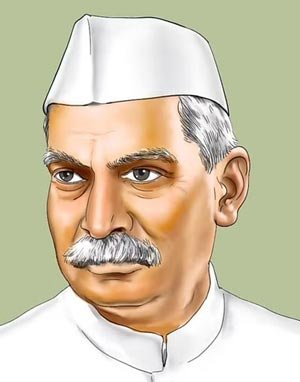
Dr. Rajendra Prasad, son of Mahadev Sahai, was born in Zeradei village in Bihar on December 3, 1884. Being the youngest in a large joint family he was greatly loved and was strongly attached to his mother and elder brother Mahendra. He was married when he was barely 12 years old to Rajvanshi Devi.
He was a brilliant student throughout school and college. He stood first in the entrance examination of the University of Calcutta and was awarded a Rs. 30 per month scholarship. It was first time that a student from Bihar had excelled. He joined the Calcutta Presidency College in 1902.
The partition of Bengal in 1905 fueled the swadeshi and boycott movements. The movements had a deep effect on students in Calcutta. One day, residents of his hostel created a bonfire of all the foreign clothings they had. When Rajendra went through his belongings he could not find a single item of foreign clothing.
In 1915, Rajendra passed the Masters in Law examination with honours, winning a gold medal. He then completed his Doctorate in Law to attain the title, Dr. Rajendra Prasad.
While Gandhiji was on a fact finding mission in Chamaparan district of Bihar, he called on Rajendra Prasad to come to Champaran with volunteers. Dr. Prasad was deeply moved by the dedication, conviction and courage that Gandhiji displayed. Here was a man alien of the parts, who had made the cause of the people of Champaran his cause.
A court notice was served to Gandhiji. He declared that he had disobeyed the order to leave Champaran in obedience to the highest law he knew, ‘the voice of conscience.’ The case against Gandhiji was dropped. From that point onward, Dr. Prasad became Gandhiji’s dedicated follower.
Gandhiji’s influence greatly altered many of Dr. Prasad’s views, most importantly, on untouchability. Gandhiji made Dr. Prasad realise that when the nation was working for a common cause, they “became of one caste, namely the caste of co-workers.” Dr. Prasad immediately simplified his already simple life. He reduced the number of servants he had to one. He no longer felt shame in sweeping the floor, or washing his own utensils.
Whenever the people suffered, Dr. Prasad was present to help reduce the pain. In 1914 floods ravaged Bihar and Bengal. Dr. Prasad became a volunteer distributing food and cloth to the flood victims. In 1934, Bihar was shaken by an earthquake. The quake caused immense damage and loss of property. The quake was followed by floods and an outbreak of malaria. Dr. Prasad dove right in with relief work, collecting food, clothes and medicine. In 1935, an earthquake hit Quetta. Dr. Prasad was not allowed to lend a hand because of Government restrictions. He did not rest. He set up relief committees in Sind and Punjab for the homeless victims that flocked there.
Dr. Prasad was shocked by the Government atrocities at Jallianwalla Bagh. He called for non-cooperation in Bihar as part of Gandhiji’s non-cooperation movement. Dr. Prasad gave up his law practice and started a National College near Patna, 1921. The college was later shifted to Sadaqat Ashram on the banks of the Ganga. The non-cooperation movement in Bihar spread like wildfire. Dr. Prasad toured the state, holding public meeting after another, collecting funds and galvanizing the nation for a complete boycott of all schools, colleges and Government offices. He urged the people to take to spinning and wear only khadi. Bihar and the entire nation was taken by storm, the people responded to the leaders’ call.
In March 1930, Gandhiji launched the Salt Satyagraha. He planned to march from Sabarmati Ashram to Dandi seashore to break the salt laws. A salt satyagraha was launched in Bihar under Dr. Prasad. Nakhas Pond in Patna was chosen as the site of the satyagraha. Dr. Prasad sold the manufactured salt to raise funds. He was sentenced to six months imprisonment.
Dr. Prasad presided over the Bombay session of the Indian National Congress in October 1934. Following the resignation of Subhash Chandra Bose as the President of the Congress in April 1939, Dr. Prasad was elected President.
On August 15, 1947 India was free. Earlier, a Constituent Assembly was formed in July 1946, to frame the Constitution of India and Dr. Rajendra Prasad was elected its President. On November 26, 1946 the Constitution of India was completed and accepted by the people of India. On January 26, 1950, the Constitution was ratified and Dr. Rajendra Prasad was elected the first President of India. Dr. Prasad transformed the regal splendor of Rashtrapati Bhavan into an elegant “Indian” home. Dr. Prasad visited many countries on missions of goodwill. In 1962, after 12 years as President, Dr. Prasad retired. He was awarded the highest civilian award of India, the Bharat Ratna. Dr. Prasad authored many books including his autobiography ‘Atmakatha’ (1946), ‘Satyagraha at Champaran’ (1922), ‘India Divided’ (1946), ‘Mahatma Gandhi and Bihar, Some Reminisences’ (1949), and ‘Bapu Ke Kadmon Mein’ (1954).
Dr. Prasad spent the last few months of his life at the Sadaqat Ashram in Patna. He died on February 28, 1963.
